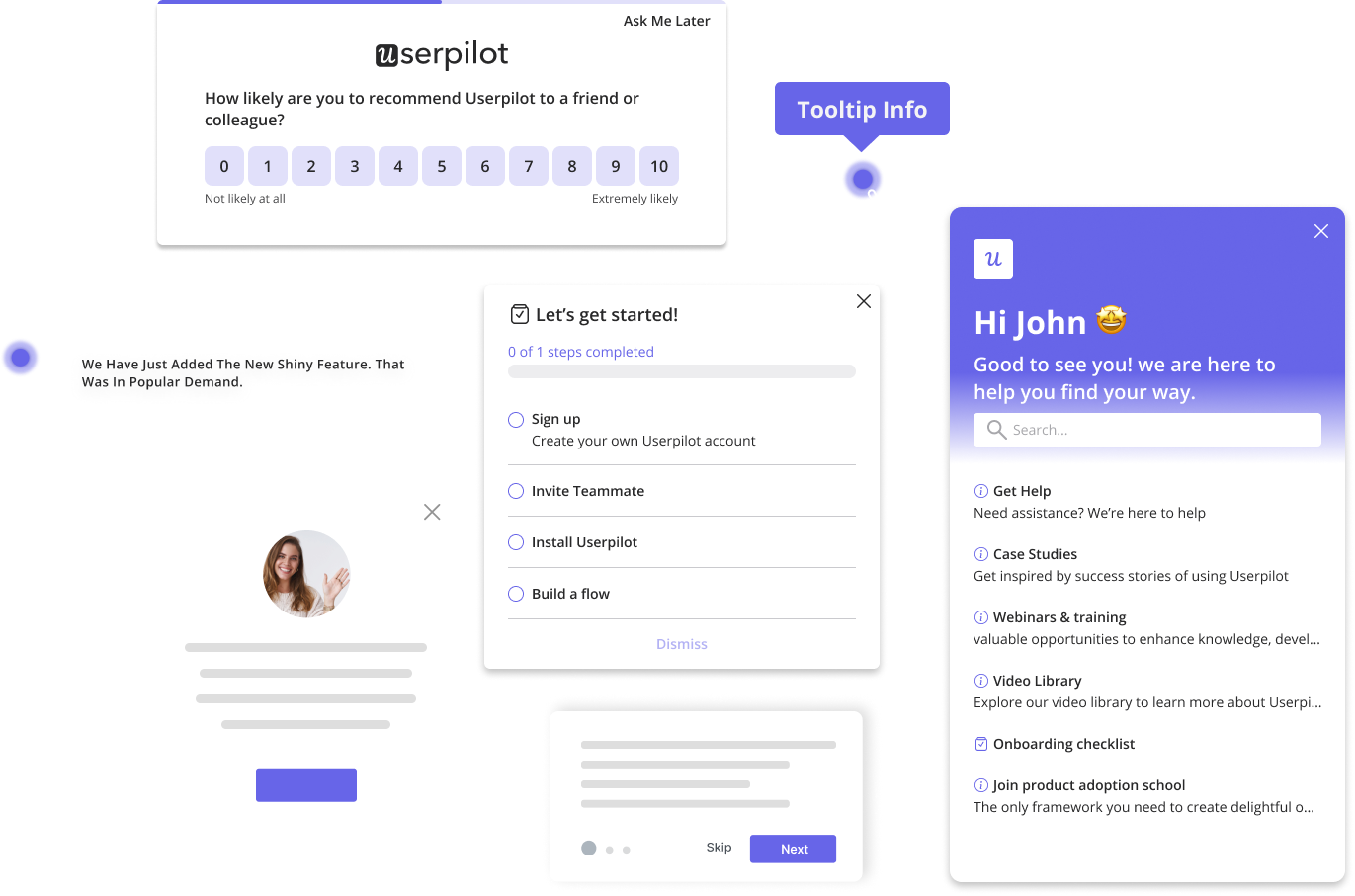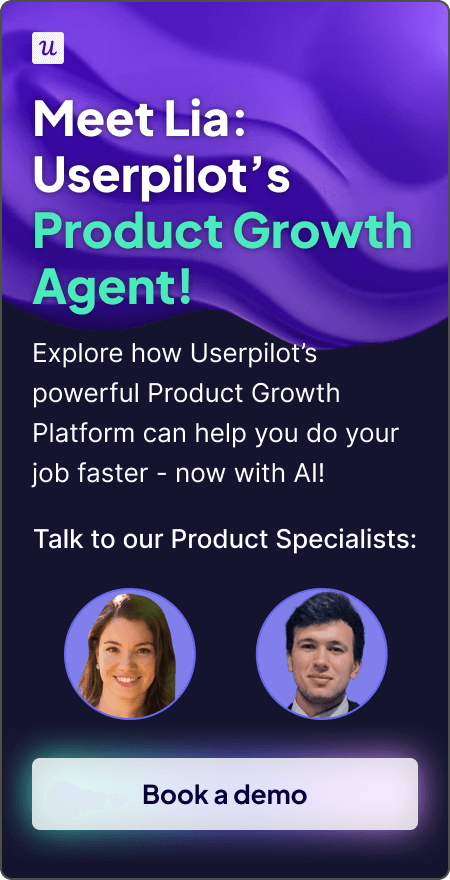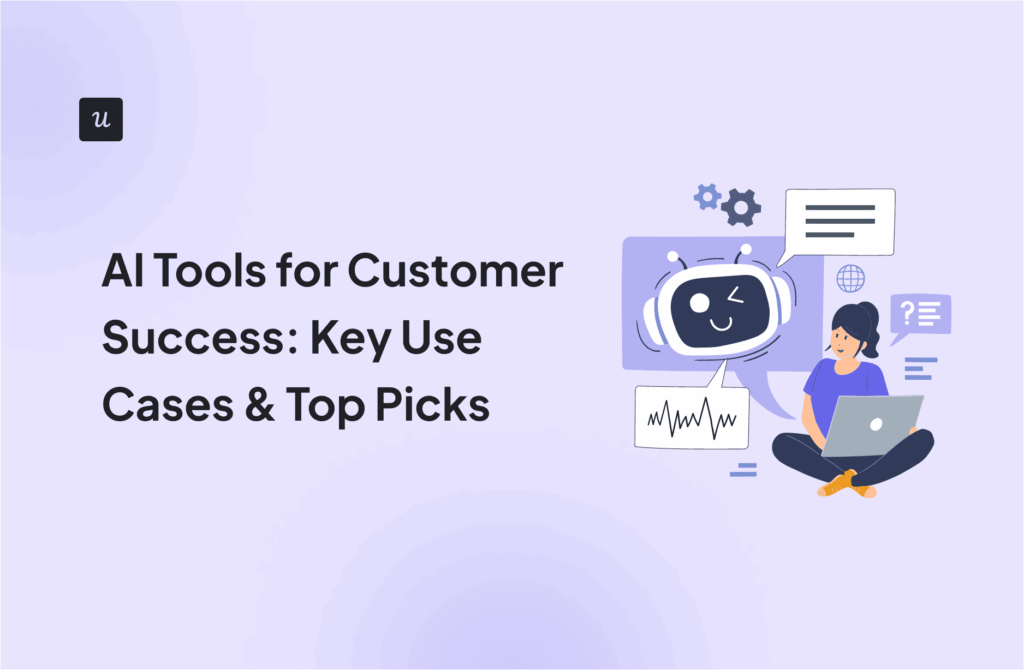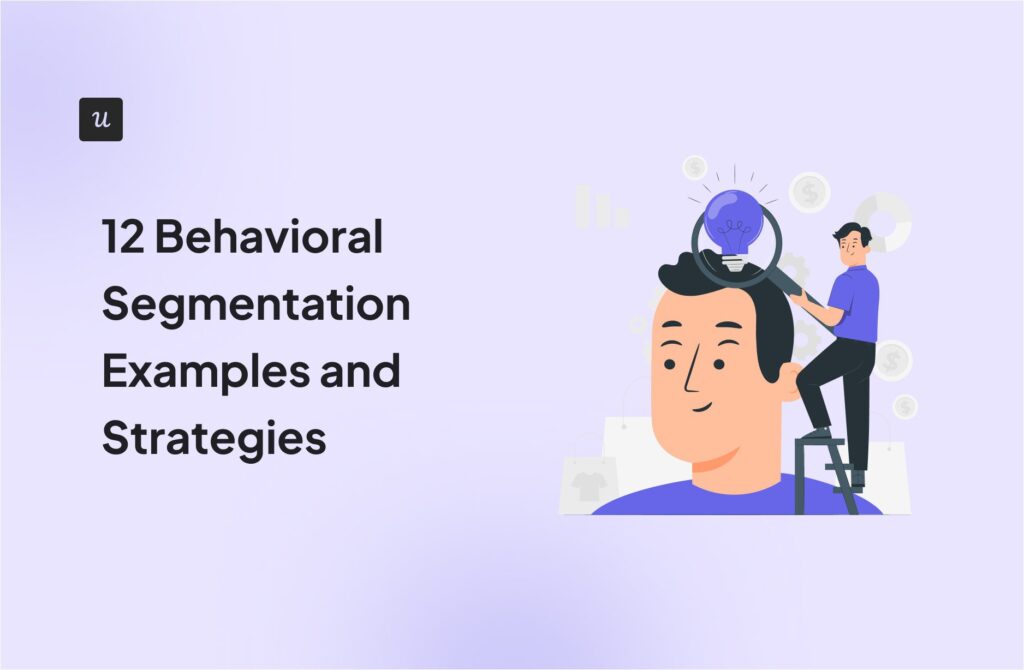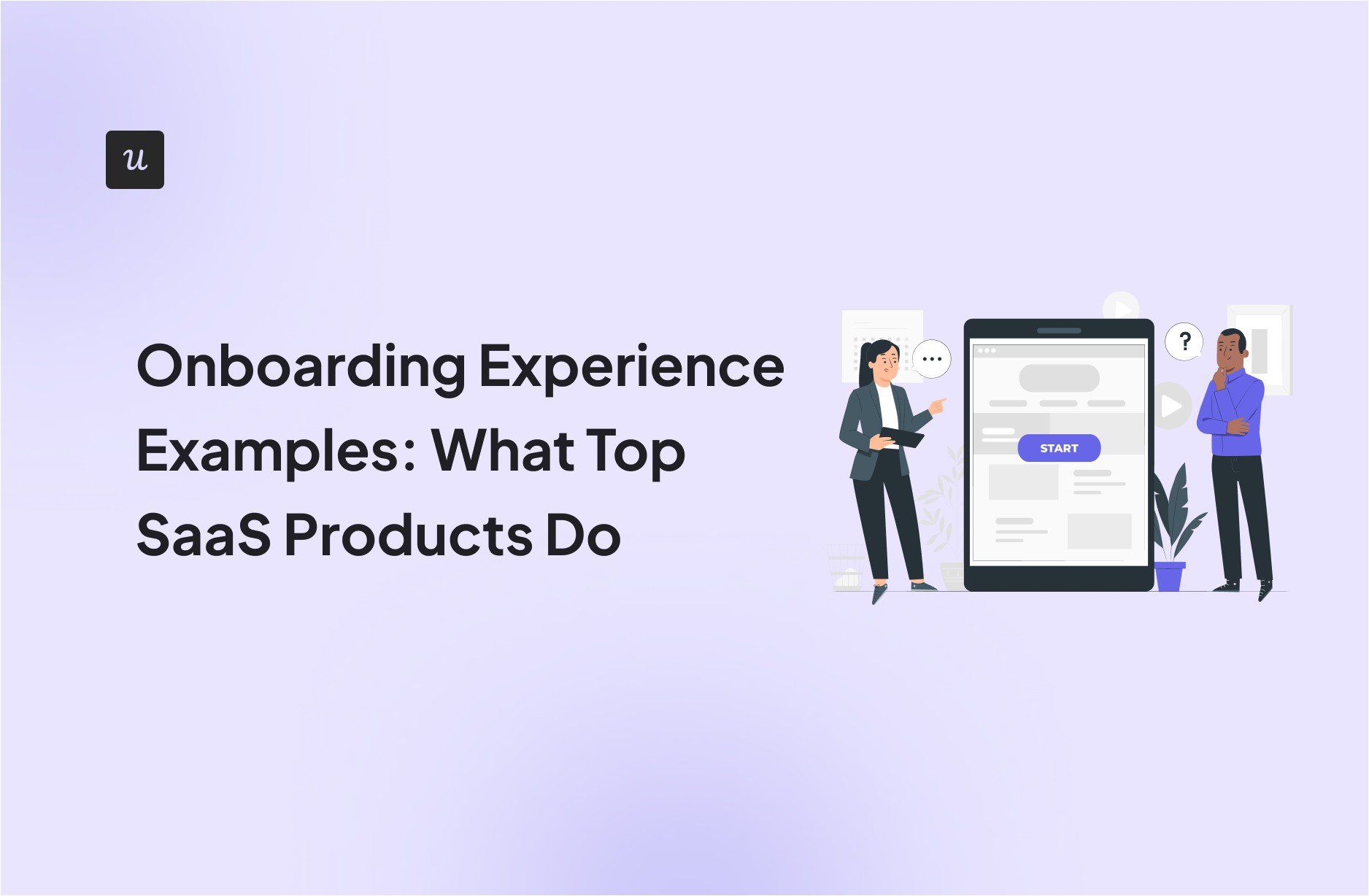
8 in 10 users delete an app because they didn’t know how to use it, according to Wyzowl’s 2020 customer onboarding research. I’ve seen this exact pattern across hundreds of SaaS onboarding experiences at Userpilot.
The difference between companies that lose users and those that keep them? My own research shows 63% of customers consider the onboarding period when deciding to subscribe, yet most companies treat it like a product tour instead of a value delivery system.
After rebuilding onboarding flows for companies Kommunicate and seeing completion rates jump from 15% to 67%, I know what separates great user onboarding from generic walkthroughs. The best practices show that onboarding helps users reach their first success, not just learn features.
In this guide, I’m breaking down real onboarding examples from top SaaS products and the specific techniques you can build in Userpilot.
Try Userpilot Now
See Why 1,000+ Teams Choose Userpilot
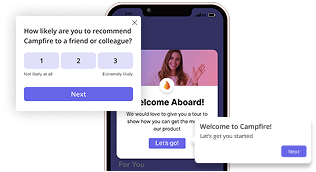
What makes a great onboarding experience
Great onboarding gets users to their first success without confusion. You are not just teaching users how the product works, but rather helping them feel confident and capable, fast.
After rebuilding flows for dozens of SaaS teams, I’ve found that successful onboarding experiences guide users to value without overwhelming them.
Here are the onboarding best practices that consistently drive actionable insights:
- Personalization is paramount: Not all users are the same. Their needs, skill levels, and goals differ. Tailoring the experience based on who they are and what they aim to achieve is non-negotiable. This means adopting a personalized onboarding approach, often driven by a smart customer segmentation strategy.
- Show, don’t just tell, using interactive experiences: Nobody wants to read a manual. Users learn best by doing. Provide interactive guides that gently lead them through key actions, rather than long, boring explanations. That’s why interactive onboarding is so powerful.
- Value first, commitment later: Get them to experience the product’s core benefit before asking for too much personal information or a big commitment. This builds trust and shows them why they should invest their time.
- Reduce friction at every turn: Every extra step, every unclear instruction, is a chance for a user to drop off. Simplify signup, streamline forms, and clarify choices. Our focus is always on making the customer onboarding process as easy as possible.
- Continuous improvement is key: Onboarding is never ‘done.’ The onboarding process starts with signup but extends through the entire user journey. You need to keep an eye on user onboarding metrics and collect in-app surveys to understand what’s working and what isn’t, then adjust.
What’s your biggest user onboarding challenge right now?
Understanding your main friction point helps tailor the right solution for your user onboarding process.
Examples of successful onboarding programs from SaaS companies
Most SaaS companies show users everything their product can do. The smart ones show users what their product will do for them.
I’ve rebuilt onboarding flows for companies that went from 15% to 60% feature adoption by making this shift. The best onboarding program activates users and delivers actionable insights.
Let me show you what each company does well, where they miss opportunities, and how you can build similar onboarding flows using Userpilot.
1. Duolingo: Leading with the product experience
Duolingo is brilliant because it defies the norm. Instead of immediately asking you to sign up, it lets you jump right into a quick language lesson. You pick a language, do a few fun exercises, and then they ask you to commit.
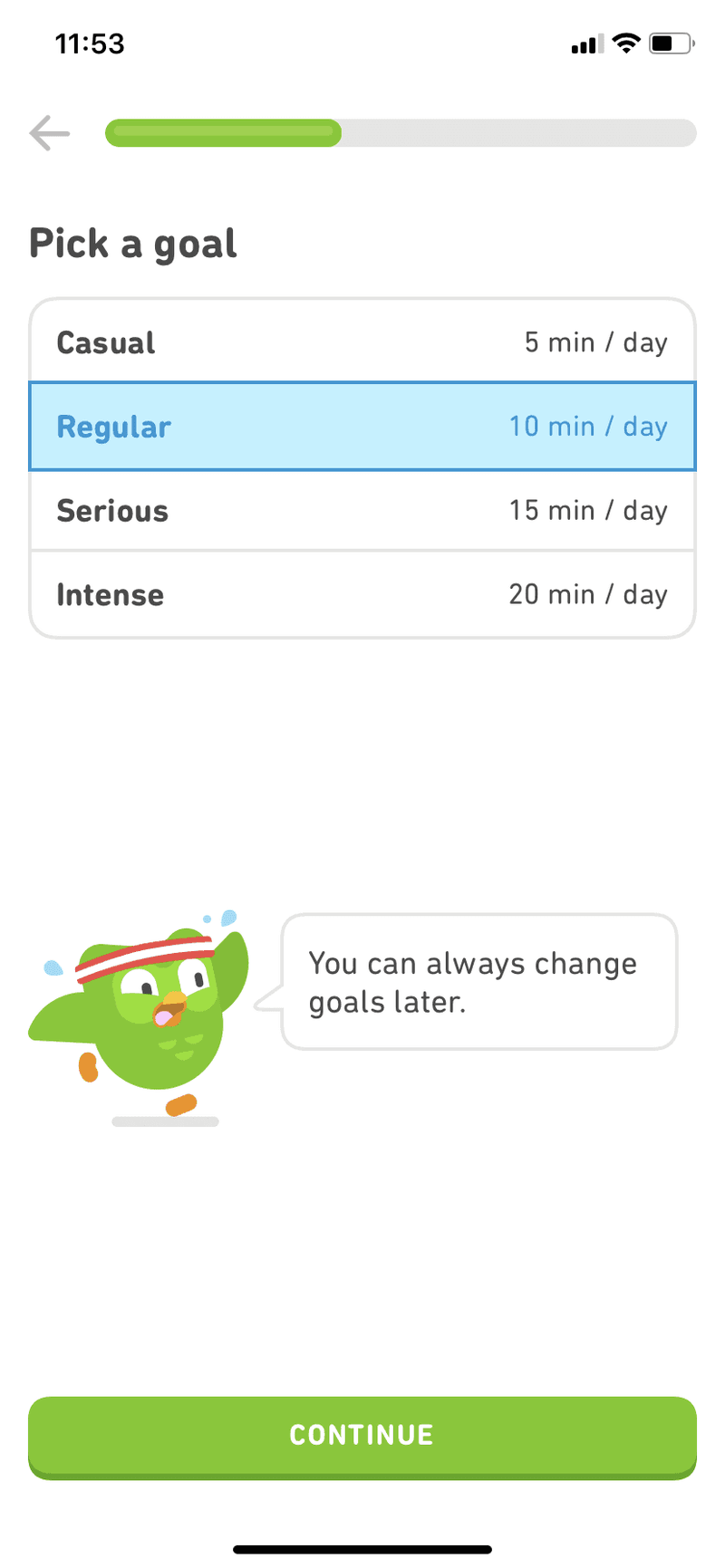
Duolingo’s onboarding experience (Image source: Good UX).
This is a prime example of gradual engagement and deferred account creation, letting you experience the value before requiring a full commitment. It leverages human psychology, specifically our desire to complete tasks once started. They also use progress bars, showing you how far you’ve come, which taps into the psychology behind progress bars to keep you going.
What can you learn from Duolingo’s onboarding experience?
I love Duolingo’s “try before you commit” approach, jumping users straight into a language lesson instead of forcing signup forms. This reduces friction while showcasing value upfront.
Once you’ve started a task, you’re more likely to finish it. Add gamified progress bars and streaks, and Duolingo turns its onboarding process into a habit-forming loop that feels completely natural.
The downside: users who bounce never enter your nurture sequences, so you lose them completely. In Userpilot, I handle this with progressive profiling, capturing email addresses after users complete their first task, when motivation is highest. You can create interactive product tours that showcase your key feature first, then use modals to capture user information.
2. Grammarly: Learning by doing with hotspots
Grammarly offers a unique demo document right after you sign up. It’s pre-filled with mistakes, inviting you to fix them using the tool. This “learn by doing” approach is incredibly effective. They guide your eye with subtle hotspots and onboarding tooltips that explain features as you interact. It shows, rather than tells, the immediate benefit. I often point to Grammarly when discussing effective product tours.
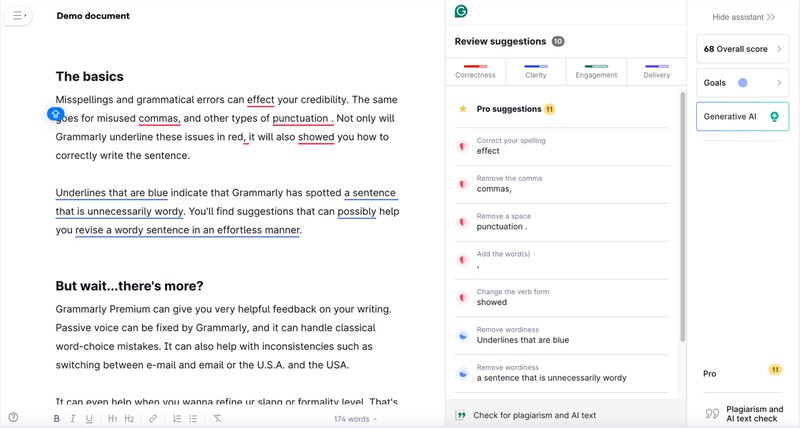
What can you learn from Grammarly’s onboarding experience?
Grammarly’s onboarding is a masterclass in “learning by doing.” Instead of dropping users into settings panels or feature tours, they hand you a pre-written document full of intentional mistakes. You fix them using Grammarly’s features and instantly see the value.
This hands-on approach creates a smooth transition using hotspots and tooltips, helping you discover the product’s utility without needing a manual. The experience creates an early habit loop because seeing your writing improve in real time is incredibly motivating.
The missed opportunity: everyone gets the same generic demo document when role-specific versions would be far more compelling.
In Userpilot, you can create interactive walkthroughs using real user scenarios. Instead of generic demos, build flows that let users complete actual tasks they’ll do in your product, with contextual guidance along the way.
3. Slack: Friendly bots and empty states
Slack excels at making a complex team communication tool feel approachable. Their onboarding uses well-designed empty states that show you what a channel will look like once populated, alongside helpful microcopy.
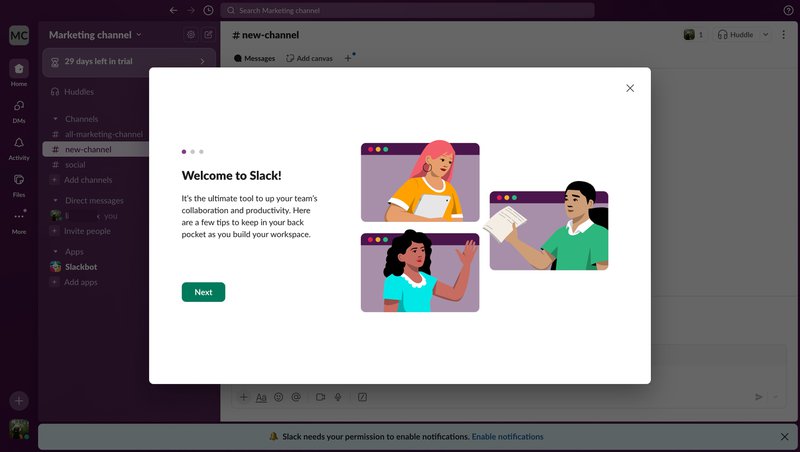
Their friendly chatbot, Slackbot, acts as a guide, providing interactive tips and making the setup feel less like a chore and more like a conversation. This approach proactively addresses potential confusion and is a great way to avoid empty states hurting your TTV.

What can you learn from Slack’s onboarding experience?
Slack’s onboarding strikes a balance between functionality and friendliness without overwhelming new users.
Their secret weapon is Slackbot, cleverly embedded in the channel sidebar like a teammate. It answers questions, offers slash command suggestions, and directs users through the onboarding process conversationally.
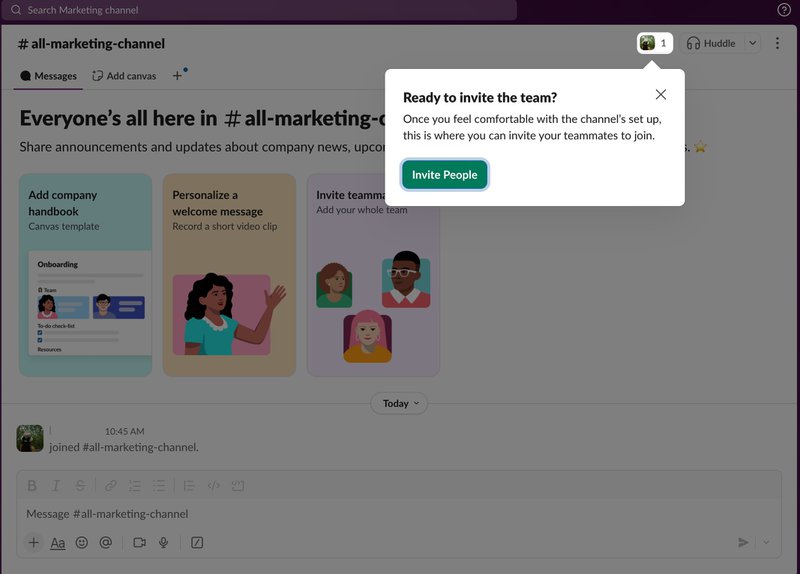
This approach works because it feels like getting help from a colleague rather than reading documentation. Pair that with thoughtful empty states and occasional tooltips, and it creates a low-friction start.
However, for a tool as feature-rich as Slack, relying on exploration alone may leave value on the table, especially for less tech-savvy users who need more intentional guidance.
4. Attention Insight: Interactive walkthroughs combined with a checklist
Attention Insight excels at getting users to their core value fast. As a product built around AI-powered heatmap analysis, their biggest activation trigger is obvious: uploading a design and generating a heatmap. Instead of overwhelming new users with options, they use a focused checklist that combines guided walkthroughs with targeted tasks, all pointing toward that one critical action.
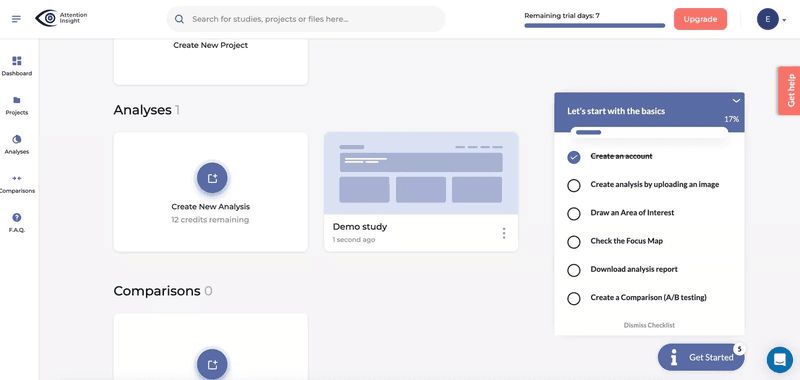
What can you learn from Attention Insights’ onboarding experience?
Attention Insight’s onboarding is laser-focused execution: get users to their first heatmap as fast as possible. Their onboarding checklist avoids common fluff like product overviews or intro videos, instead using interactive walkthroughs embedded within the UI. Each item on the checklist nudges users toward heatmap generation, the feature that delivers their “Aha!” moment.
This approach works because it’s entirely aligned with the product’s value proposition. The walkthroughs aren’t overly long or generic; they’re contextual and keep users on track without confusion.
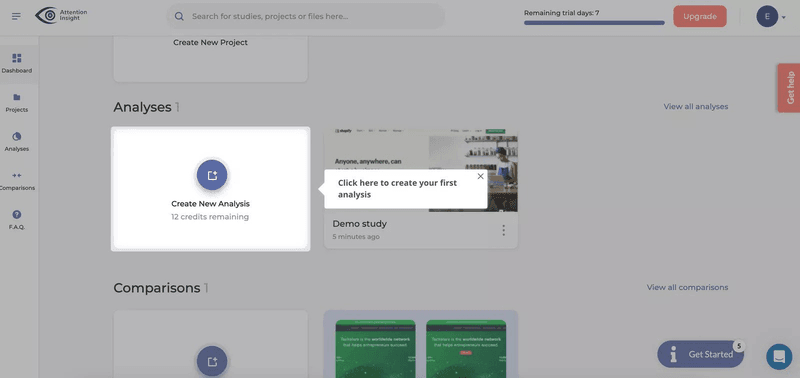
However, once users complete the initial checklist, the flow ends. Introducing follow-up checklists for advanced features could improve feature adoption beyond the core heatmap functionality.
5. Groupize: Onboarding gamification with a visual assistant
They take a creative approach to onboarding by using a gamified visual assistant called G.G. (Groupize Guide). Instead of walking users through static tours, G.G. acts like an embedded event planning expert, offering real-time support via interactive walkthroughs and progress-based checklists. What makes it effective is user control: the assistant can be dismissed at any time and accessed later from the resource center.
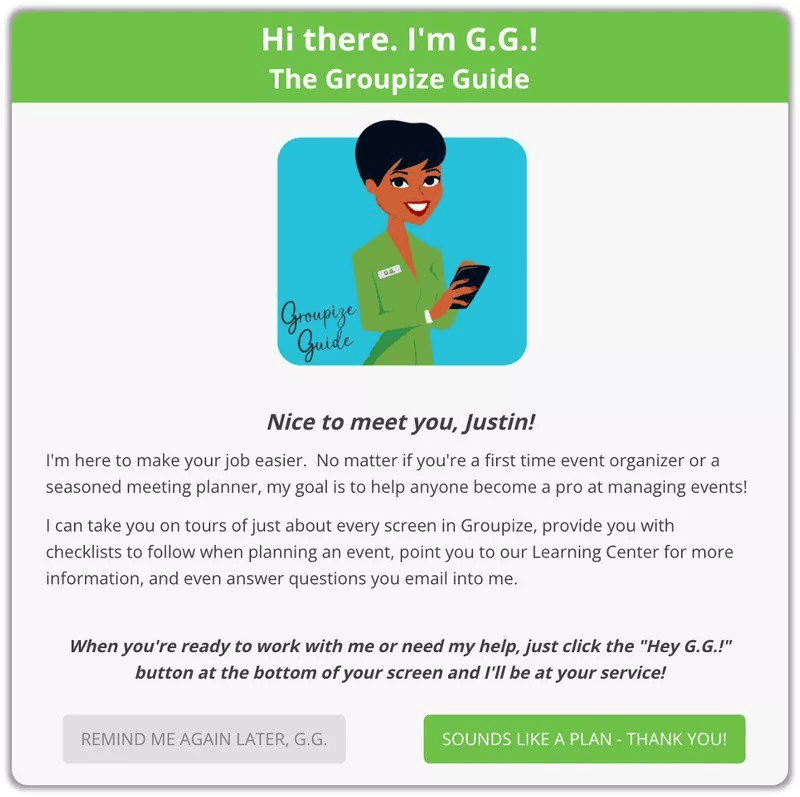
What can you learn from Groupize’s onboarding experience?
Gamification doesn’t have to mean badges and points. In this case, the gamified element is a friendly, helpful visual assistant that makes onboarding feel approachable and engaging. By letting users choose when and how to interact with G.G., Groupize creates a more respectful, user-led onboarding experience.
This approach works because it gives users agency while still offering structured guidance. Users feel in control rather than forced through a rigid sequence.
However, visual assistants can feel gimmicky if not executed well. The key is making the assistant genuinely helpful rather than just decorative.
6. Intercom: Human-led support for in-app guidance
Intercom blends human-led support with in-app guidance, creating a hybrid onboarding experience that feels both personal and structured.
New users encounter tooltips and modals with conversational tones during exploration, effectively serving as mini guided tours. It feels like joining a product demo led by a trusted teammate rather than following a self-guided slide deck.
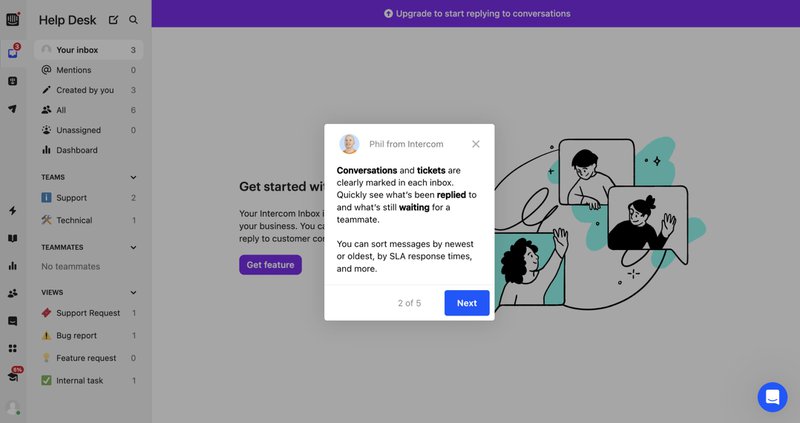
What can you learn from Intercom’s onboarding experience?
Intercom leans on strong brand familiarity and chat interfaces to make onboarding feel intuitive. Users receive contextual tips and overlays at just the right moments, making the experience feel less like an onboarding flow and more like helpful peer interaction.
This approach works best when users are already familiar with modern UI patterns and need gentle nudges rather than comprehensive guidance.
However, it functions more like a static product tour than a dynamic, action-driven walkthrough. Users become passive observers rather than active participants, which can be problematic for complex products requiring multi-step activation flows.
7. Amplitude: One-line setup with snippet copy and AI support
Amplitude’s onboarding focuses on a single objective: getting users to connect their data as quickly as possible.
Immediately after signing up, users land on a setup screen with a one-line JavaScript snippet, copy buttons, alternate SDK options, and an AI-powered setup assistant. It’s clean, efficient, and technically empowering for developers who just want to drop in code and move on.
Amplitude removes setup friction by offering a one-line snippet with instant copy and AI-powered guidance so users can start tracking data in seconds.
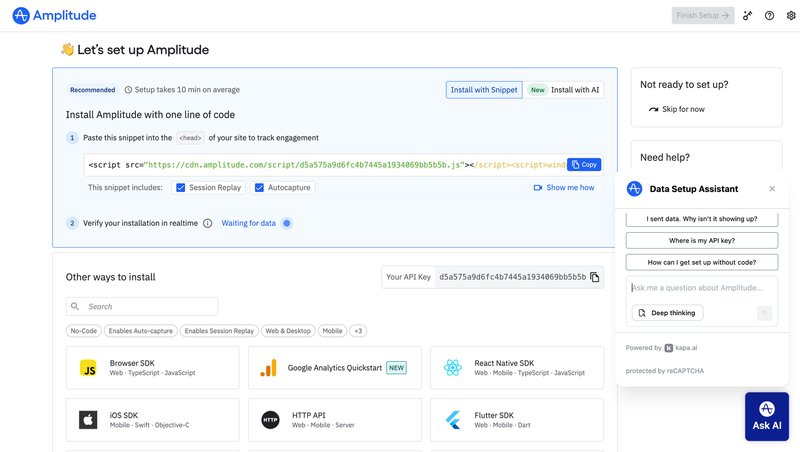
What can you learn from Amplitude’s onboarding experience?
Amplitude aligns its onboarding flow perfectly with product activation: connecting real data. This direct, no-nonsense approach works well for technical users who are ready to integrate immediately.
The problem: Amplitude recently buried their demo exploration option, forcing users who skip setup into an empty dashboard with no sample data or guidance. Previously, users could easily access a demo to explore the product’s capabilities before committing to implementation.
This change appears designed to push conversion. Since many users who skip data connection don’t convert, but it creates a worse onboarding experience. Users now face a stark choice: implement immediately or abandon the product entirely.
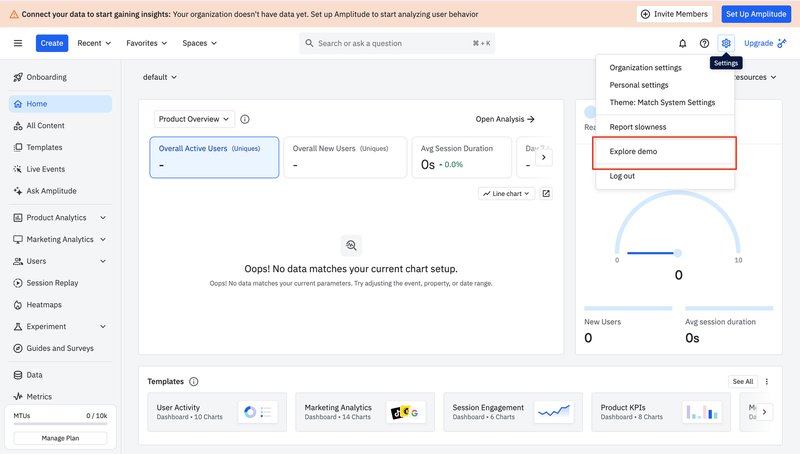
The lesson: while driving users toward core actions can improve conversion metrics, removing fallback experiences often backfires. The most effective onboarding provides multiple pathways to value, allowing both ready-to-implement users and those who need convincing to find their preferred route forward. Amplitude’s previous approach that offered both immediate setup and demo exploration was superior from a user experience standpoint, even if it may have had lower immediate conversion rates.
8. Miro: Interactive onboarding steps with milestone celebration
Miro nails interactive onboarding by immersing new users directly into a collaborative whiteboard experience.
Immediately after signing up, users are guided with simple, clear instructions teaching them to navigate the canvas using gestures like zoom and drag.
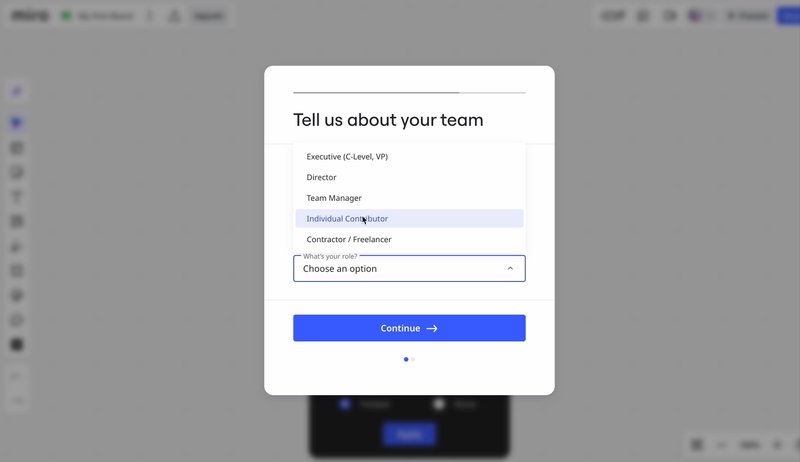
It’s “learn by doing” that feels native and non-intrusive, with playful micro-interactions like cheerful “Yeah!” pop-ups when you complete tasks.
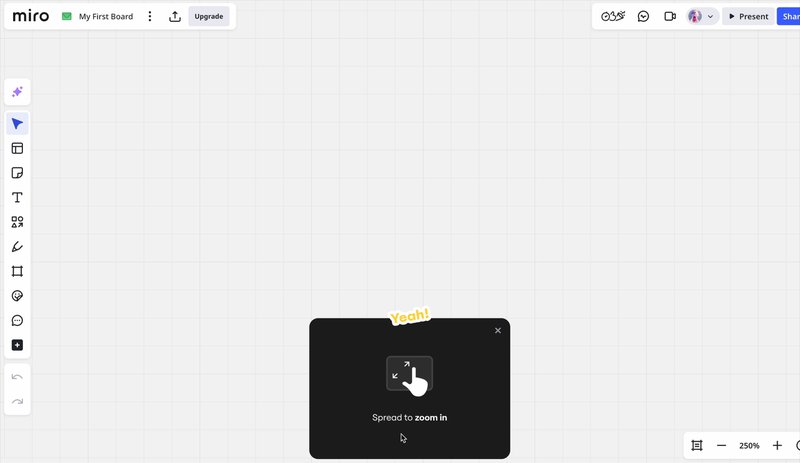
What can you learn from Miro’s onboarding experience?
Miro’s strength lies in aligning its onboarding flow with core product behavior. Instead of delaying engagement with forms or setup steps, it puts users right in the driver’s seat.
This reduces time to value and builds confidence fast. The milestone celebration adds motivational nudges, reinforcing progress and encouraging exploration.

However, there’s a missed personalization opportunity. Miro asks about user roles and industry during signup, but doesn’t reflect that in the experience. Users get a blank canvas either way, when they could get relevant templates or starter boards tailored to their context.
9. Airtable: AI assistant as your co-creator during onboarding
Airtable’s onboarding introduces AI as an actual co-pilot. After asking for your company and role, their assistant Omni instantly generates use case suggestions based on your input.
Whether you’re in marketing, product, or operations, it auto-fills relevant app ideas so you can get started with a single click.

You’re also presented with tailored options: ready-to-use templates or the ability to import your own spreadsheets.
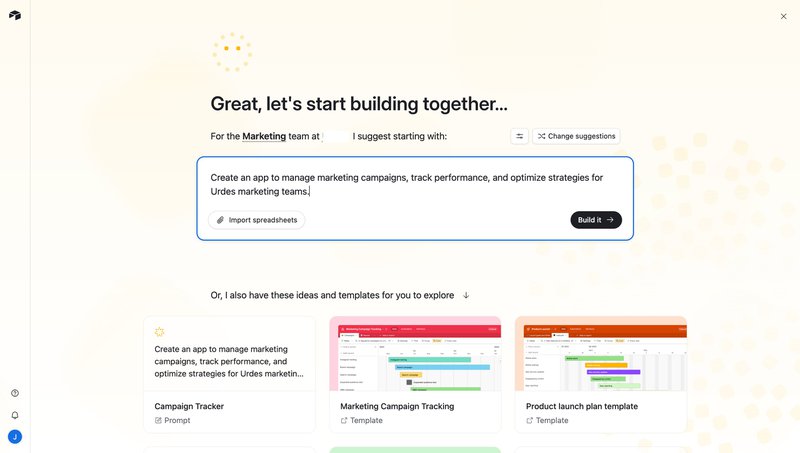
What can you learn from Airtable’s onboarding experience?
By leveraging AI to pre-generate actionable content, Airtable drastically lowers the barrier to entry. It’s a strong example of how AI can create a pull effect rather than pushing users to figure things out themselves.
This smart automation doesn’t just save time, it builds confidence early by nudging users toward success before they even know what to ask for.
However, the AI suggestions could be more specific to actual use cases rather than generic templates. More contextual recommendations based on company size or industry vertical would make the experience even more relevant.
Want more insights like this? Join us at Product Drive 2025, a free virtual event powered by Userpilot, where top growth and onboarding leaders will show you how to leverage AI to drive product adoption and user success. Reserve your spot here!
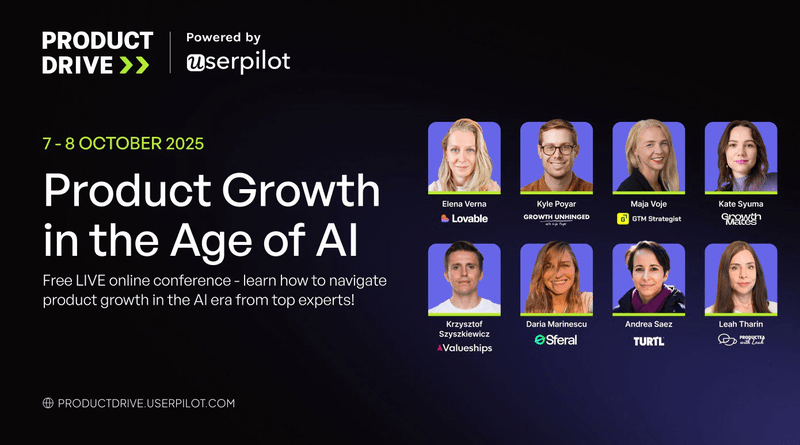
Types of UX/UI patterns to enhance onboarding experiences
When designing onboarding flows, strategic use of seven specific UI patterns prevents cognitive overload while leading users to activation:
1. Tooltips
Tooltips are small, context-driven hints that appear when users interact with a UI element or even when they land on a specific page without interrupting workflow. They are ideal training materials that provide micro-guidance during onboarding activities or feature discovery, providing clarity when needed most.
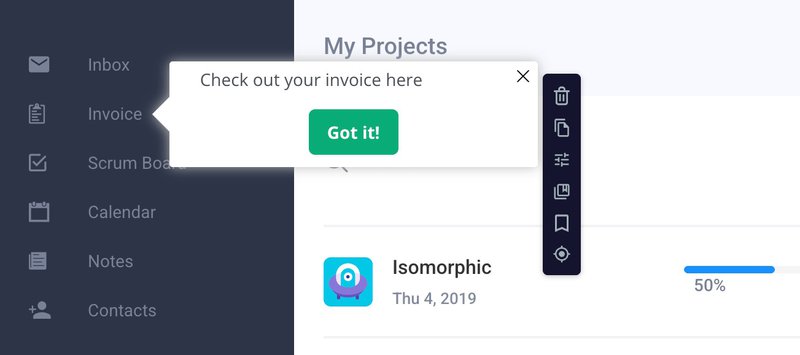
At Kommunicate, they used contextual tooltips triggered by user behavior (not just hovers) to help users navigate through chat customization. The result is an 86% increase in feature adoption because the guidance felt intuitive, not interruptive.
2. Hotspots
Hotspots are attention-grabbing, pulsing indicators that hint at interactive elements deserving exploration. They’re excellent for unearthing hidden or underused features without cluttering the interface during the onboarding process.
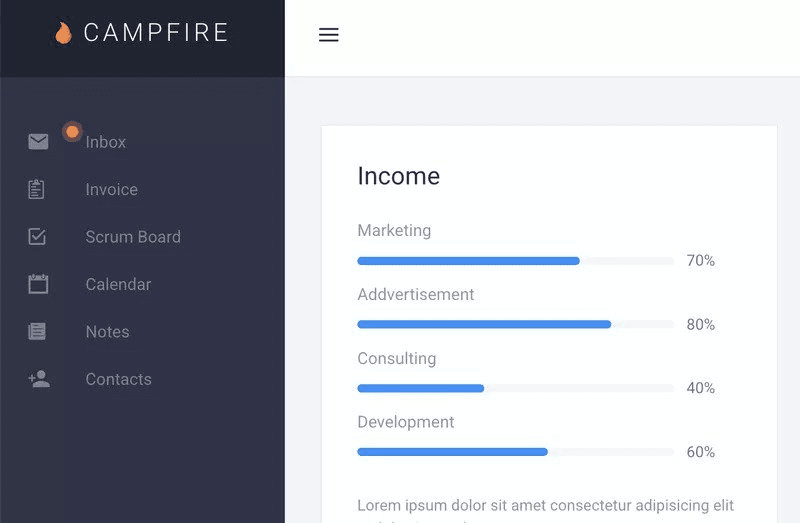
Hotspots reduce cognitive load and naturally draw user attention. In Userpilot, I often layer hotspots with tooltips, making the guidance feel dynamic yet unobtrusive for smooth onboarding programs.
3. Modals
Modals are full-screen or overlay prompts best reserved for critical onboarding tasks: setting up user persona-based paths, collecting essential setup data, or introducing core features. Think of them as dedicated UX moments with high value and no distractions.
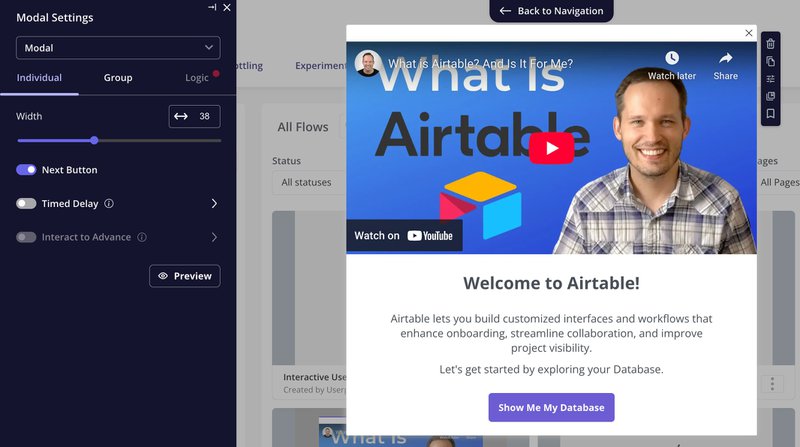
In practice, you can use modals sparingly in onboarding flows, typically for tasks that unlock real product depth.
4. Slideouts
Slideouts are side panels that provide in-context onboarding without hijacking attention. They’re perfect for onboarding checklists, progress updates, or optional next steps. Slideouts are embedded UX patterns that are larger in scope than tooltips but still non-interruptive.
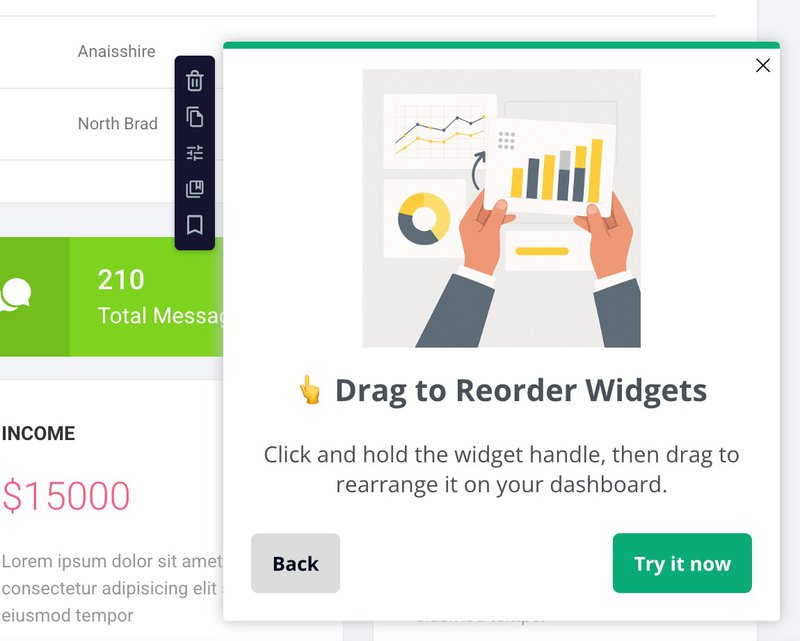
I’ve seen completion rates jump by 40% when users can see their onboarding progress in a slideout while actively using the product.
5. Interactive product tours
These are structured sequences (typically 3-5 steps) combining tooltips, hotspots, modals, or slideouts to guide users toward activation. The goal isn’t just feature awareness but to ensure users complete the action that reveals value.

Interactive walkthroughs built using these patterns can significantly boost feature engagement and create a positive onboarding process.
6. Onboarding checklists with progress bars
Checklists make users feel like they’re making tangible progress, turning tasks into a gamified experience. Userpilot supports smart onboarding checklists that adapt based on actions taken, even across sessions, but still highlight the next logical step. These provide continuous support and reduce drop-offs by making the path to value transparent.

7. Branched onboarding experiences
Not all users are the same, and one-size-fits-all onboarding underdelivers. Branched flows tailor the user onboarding experience based on user persona or behavior, increasing relevance and engagement.
Userpilot excels here, enabling you to build conditional onboarding materials and paths, each optimized to different user segments, without any code.
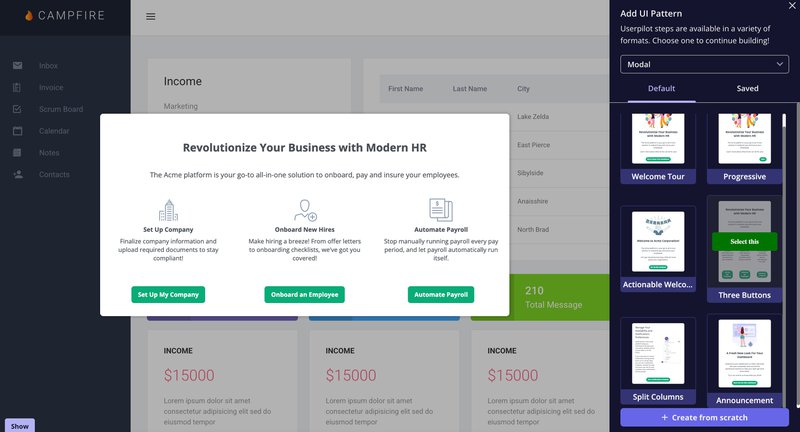
Userpilot: Your partner in crafting outstanding onboarding
Most teams see these examples and think, ‘Great, but our dev team is swamped for the next six months.’ That’s exactly why we built Userpilot’s no-code platform. My team helps product teams implement these exact strategies in days, not development sprints.
Our platform is built to help product, growth, and customer success teams create best-in-class user onboarding experiences without writing a single line of code. We give you a suite of tools to implement the strategies we just discussed:
- No-code UI patterns: Easily build flows with modals, native tooltips, hotspots, and slideouts. You can even design custom banners for announcements, all with our intuitive visual builder. Want to test which flow works best? Our A/B testing features make it simple.
- Advanced segmentation and personalization: Target users with precision based on their segments, properties, and in-app behavior. Our dynamic content personalization lets you address users by name or tailor messages to their specific role, ensuring a truly relevant journey.
- Contextual help and self-service: Reduce support load by integrating a resource center right into your app. Fill it with video tutorials, FAQs, or links to your knowledge base articles, giving users instant answers on demand. You can even translate your content with localization features.
- Data-driven optimization: Track user behavior analytics with ease, without heavy coding. Use funnel analysis to pinpoint drop-off points in your onboarding flow or path analysis to understand how users navigate your product. Dive deeper with session replay to see exactly where users get stuck.
- AI-powered content creation: Struggle with crafting the perfect copy for your flow steps or checklists? Our Userpilot’s AI assistant helps you instantly generate or refine UI text, summarize long explanations, or simply fix grammar, saving your team valuable time. Instead of wrestling with blank screens, you focus on strategy while AI handles the writing.
Want to see what’s next? Our founder, Yazan, is unveiling exciting new AI capabilities at ProductDrive that will transform how you personalize onboarding experiences. Register for “AI for Product Growth: Turning Data into Hyper-Personalized Experiences” to get early access to features that will make your onboarding flows even smarter.
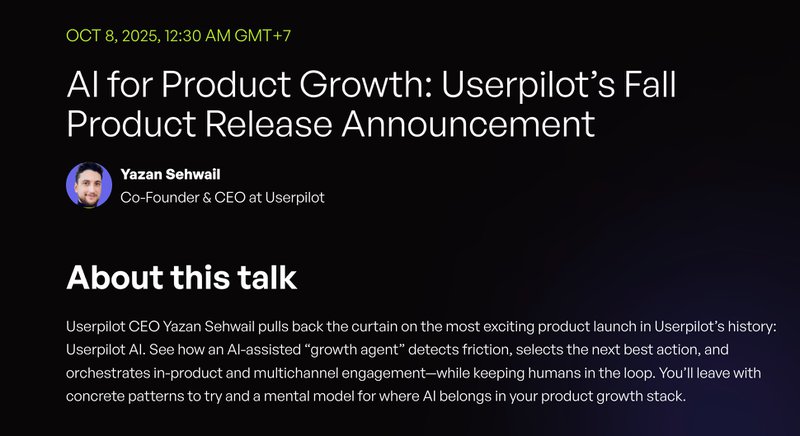
- Mobile-first onboarding: For mobile apps, we offer dedicated tools to create engaging mobile app onboarding experiences, including carousels and slideouts tailored for smaller screens, complete with push notifications to re-engage users.
Drive product growth with a great onboarding experience!
Your onboarding is either making users successful or making them leave. There’s no middle ground. I’ve rebuilt flows for companies that went from “Why aren’t users adopting our features?” to “How do we keep up with all these upgrade requests?” The shift happens when you stop thinking like a product demo and start thinking like a personal consultant.
Here’s my takeaway: great user onboarding experiences aren’t a setup step. They’re your most reliable growth driver. When you guide users to meaningful outcomes using the right tools, you create a positive onboarding program that compounds over time.
Ready to build onboarding flows that actually convert? Book a demo with Userpilot to see how our interactive onboarding tools work.

